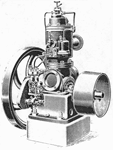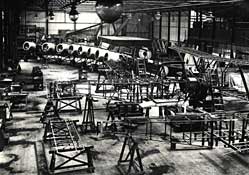 |
|

Westland History -
|
The Petter engines were in considerable demand and the Nautilus Works, situated in the centre of Yeovil was producing up to 1500 engines annually during the years immediately before the war. Petters was a family company, run by twin brothers, Ernest and Percy Petter. Such was the success of their oil engines, that by the outbreak of war they were already looking for a suitable site for a new foundry near the railway. In addition to the foundry, some 75 acres of farmland was purchased in order to build a garden village to house the expected increase in the workforce. The whole plan was changed by the onset of war, as hostilities gathered momentum, so the consumption of ammunition and equipment increased, outstripping the existing capacity and there was an immediate appeal from The Petters responded immediately, and telegrams were sent to both the War Office and the Admiralty offering to place their facilities and workforce at government disposal, for use in any capacity. Their approach was received with some indifference by the War Office, but a prompt reply came from the Admiralty. Following a meeting in London, it was suggested that the local sewing skills in the gloving industry, combined with Petters engineering capability could be well adapted for aircraft manufacture. The result was an order for twelve Short Type 184 patrol seaplanes, followed by a contract to build twenty Short Type 166, the completed seaplanes were transported to Hamble for flight testing. The success with the seaplanes resulted in a contract to build Sopwith 1½ Strutters.
Towards the end of the war, Westland were sub-contracted by de-Havilland to install the American Liberty engine in the DH-9 to produce the DH-9A, having completed this work satisfactorily, Westland became the prime contractor for the type. This was an important factor in establishing Westland as a major company in Britain's aircraft industry. Westland were also contracted to build 75 Vickers Vimys and had completed 25 of these when the war ended, by which time over 1100 aircraft had been delivered. Many of the original buildings, including the large hangar constructed for Vimy production, are still in use within the Yeovil factory today. With peace came uncertainty. In the years which followed the First World War, Westland designed a number of civil aircraft including the Limousine, Three engined Wessex airliner, Woodpidgeon and Widgeon.
|
|
COPYRIGHT © and all other RIGHTS in these pages are reserved by AGUSTAWESTLAND LIMITED.


 The manufacture of aircraft has been undertaken on the Yeovil site of what is now Westland Helicopters since 1915. At the turn of the century, before the first aeroplane had flown, Yeovil was better known as a market town and centre for the gloving industry, the only significant engineering activity in the area, was with Petters limited who produced oil engines providing power for agricultural purposes and light industry.
The manufacture of aircraft has been undertaken on the Yeovil site of what is now Westland Helicopters since 1915. At the turn of the century, before the first aeroplane had flown, Yeovil was better known as a market town and centre for the gloving industry, the only significant engineering activity in the area, was with Petters limited who produced oil engines providing power for agricultural purposes and light industry.  the government for companies to turn their attention to the armament manufacture.
the government for companies to turn their attention to the armament manufacture. By 1916 construction of the factory and airfield was well in hand, completion of Sopwith contracts was quickly followed by order to build
By 1916 construction of the factory and airfield was well in hand, completion of Sopwith contracts was quickly followed by order to build 